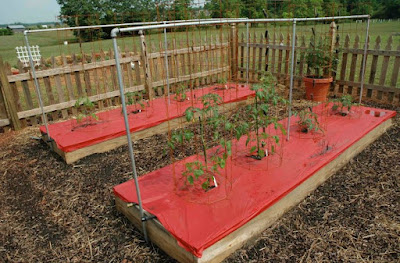I thought that plastic mulch would make my gardening easier, and it can… but only if you do it correctly. It is typically used to increase the temperature of the soil to improve the yield of warm weather plants like tomatoes and peppers. I wanted the additional benefit of fewer weeds and less wind erosion since my community garden is in a very windy location. Next year, I will use it again, but I do things very differently based on what I’ve learned.
First, let’s talk about why it is beneficial. The plastic traps solar heat and warms the soil. This can both extend the growing season and increase the fruit yield. In fact, black plastic can increase the soil temperature 5°F at a depth of 2 inches.
Although there are several colors for plastic mulch, black and red are the most common. Researchers have shown that tomatoes, basil, strawberries, and eggplant all perform better with red compared to black plastic. You can increase your tomato yield as much as 20%. It also reduces tomato blight since there is less water splash back.
I did not see any improvement in my tomatoes because I did not install my plastic properly. The heat transfer is not effective unless you have direct contact between the soil and plastic. To get the best contact, prep your soil and install your irrigation. Your irrigation needs to lay flush with top of the soil. You should warm up the plastic by bringing it into your home or laying it in the sun. This will help its flexibility and improve your contact with the soil. Ideally, you should bury the edges of the plastic a couple inches deep to prevent any movement from wind. Alternatively, you can stake it down. I will be prepping my garden in early spring so that the plastic has several weeks to start warming up the soil before I plant.
When you cut holes to insert your plants, it is very important that the plastic doesn’t touch the plants as it can easily burn them. The best way to fertilize is liquid fertilizer through your irrigation system. July is a good time to remove your plastic mulch as the soil temperatures can get too high.
Honestly, I found the plastic mulch to be a lot of work, and most gardeners only get an average of 12% increased yield from certain plants. I only recommend it if you get other benefits such as reduced blight, less wind erosion, weed management, or you have limited space and you want to maximize the few plants you can grow.
For more information:

